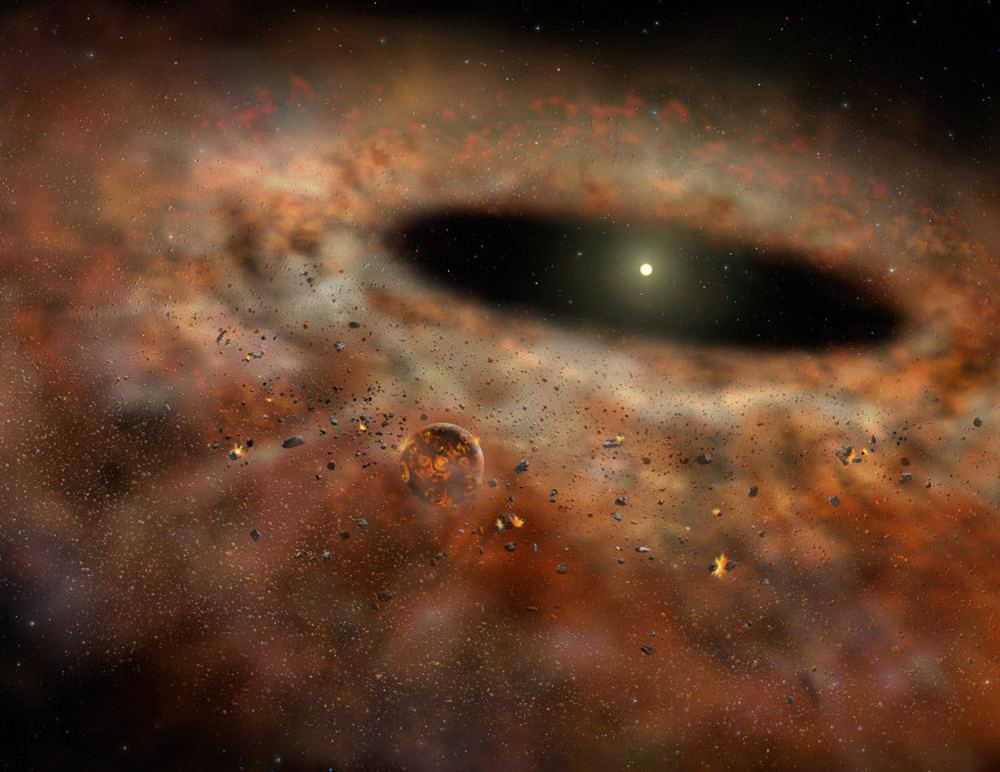Many planetary systems may get snuffed out before they even get a chance to form, according to new research. The culprit: nearby stars, capable of evaporating entire protoplanetary disks just when they begin to form.
Stars tend to form in clusters as a single giant nebula fragments into many smaller pieces. Naturally, some stars will form first. Among those stars will be large, hot ones, capable of pumping out tons of intense high-energy radiation.
And where does all that radiation go? Right into the disks of gas and dust that swirl around neighboring, less-developed stars.
Francisca Concha-Ramírez, a graduate student at the University of Leiden, led research involving large numbers of computer simulations of newly-forming planetary systems. The simulations took into account the complicating effects of radiation from nearby stars.
They found that when neighboring stars are too close, the radiation from those stars blows away dust from young protoplanetary systems. This deprives those systems of the crucial building blocks for constructing planets, potentially robbing those stars of planetary systems.
Concha-Ramírez then compared her simulations to observations of nearby star-forming regions, like the Orion Nebula. “Our simulations matched the observations. We saw that discs with many neighboring stars were lighter than discs with few neighboring stars. The radiation from stars evaporates the dust in the discs in a process that we call photoevaporation. Photoevaporation is the biggest cause of the discs’ weight loss.”
The results suggest that for a protoplanetary disk to survive, it has to get away from its neighbors. One way to do that it through a collision, which may have happened in the early days of our own solar system.
“A collision may have taken place between our circumstellar disc and another disc,” says Concha-Ramírez. “We can see proof of this at the edge of our solar system, in the region of the planet Neptune. Here there are suddenly much fewer asteroids, which suggests that another disc could have nabbed material. And there is another interesting clue that there might have been a collision between discs: asteroids that, in relation to the Earth, orbit the sun on a different plane. These asteroids probably come from another disc.”


That is an interesting find.
This I had to check:
“And there is another interesting clue that there might have been a collision between discs: asteroids that, in relation to the Earth, orbit the sun on a different plane. These asteroids probably come from another disc.”
Her latest paper [ https://arxiv.org/pdf/2101.07826.pdf ] references that:
“The highly eccentric and inclined orbits of the Sednitos, a group of 13 detected planetoids in the outskirts of the solar system, suggest they might have been captured from the disc of a passing nearby star (Jílková et al. 2015).”
So Jílková et al. 2015 [ https://arxiv.org/pdf/1506.03105.pdf ] describe the detached KBOs that usually either are attributed to Planet Nine or to selection bias.
FWIW. this is what Batygin and Brown said on that [ https://iopscience.iop.org/article/10.3847/0004-6256/151/2/22 ]:
“Further problems may potentially arise with the Kozai hypothesis. Trujillo & Sheppard (2014) point out that the Kozai mechanism allows libration about both ? = 0 as well as ? = 180, and the lack of ? ~ 180 objects suggests that some additional process originally caused the objects to obtain ? ~ 0. To this end, they invoke a strong stellar encounter to generate the desired configuration. Recent work (Jílková et al. 2015) shows how such an encounter could, in principle, lead to initial conditions that would be compatible with this narrative. Perhaps a greater difficulty lies in that the dynamical effects of such a massive perturber might have already been visible in the inner solar system. Iorio (2014) analyzed the effects of a distant perturber on the precession of the apsidal lines of the inner planets and suggests that, particularly for low-inclination perturbers, objects more massive than the Earth with a ~ 200–300 AU are ruled out from the data (see also Iorio 2012).”